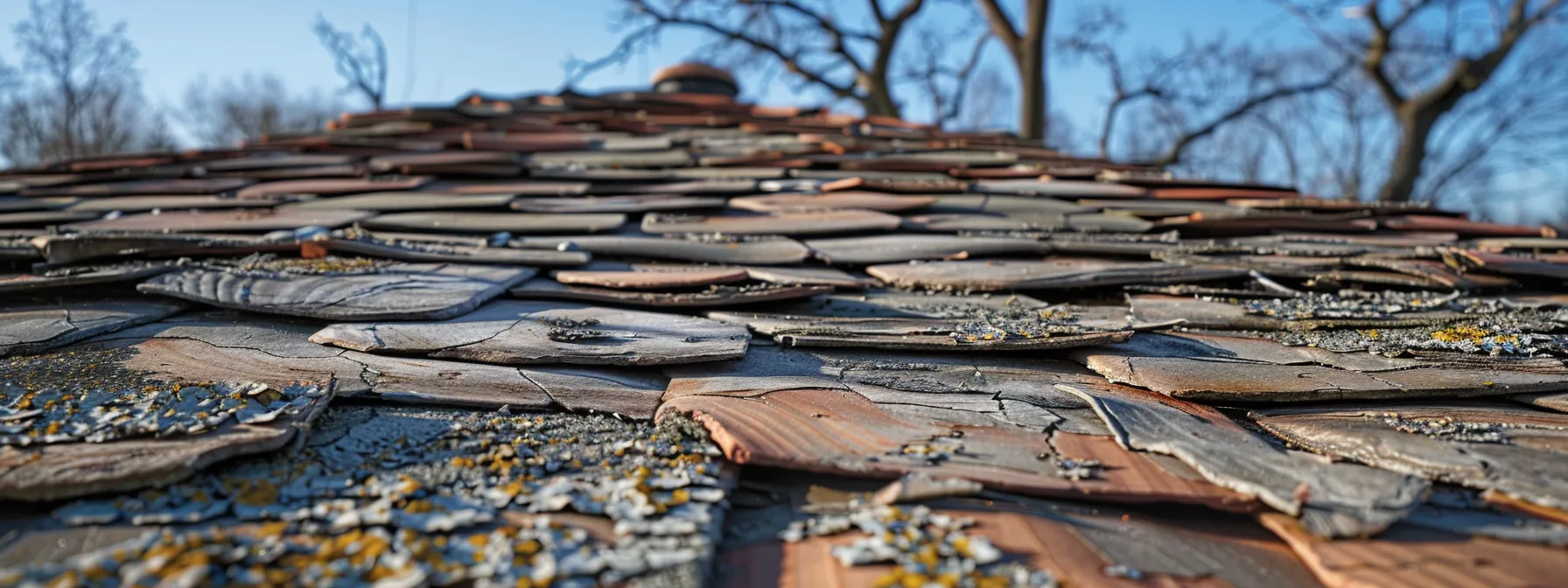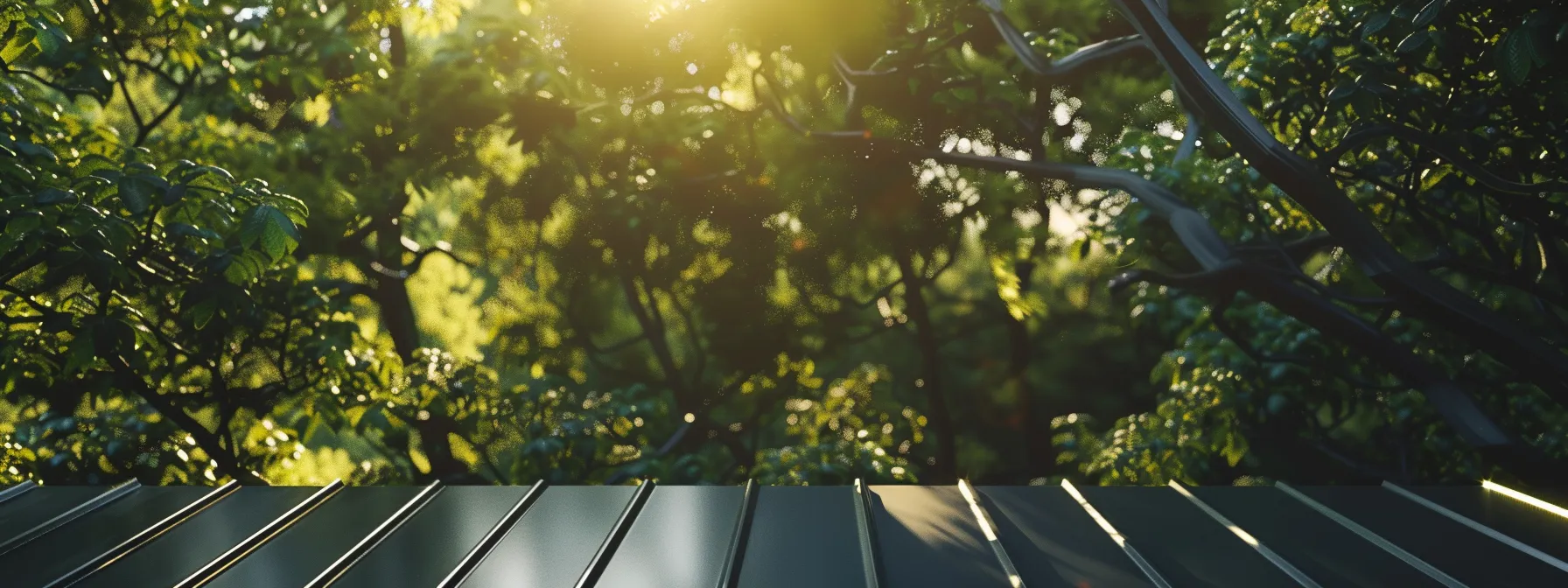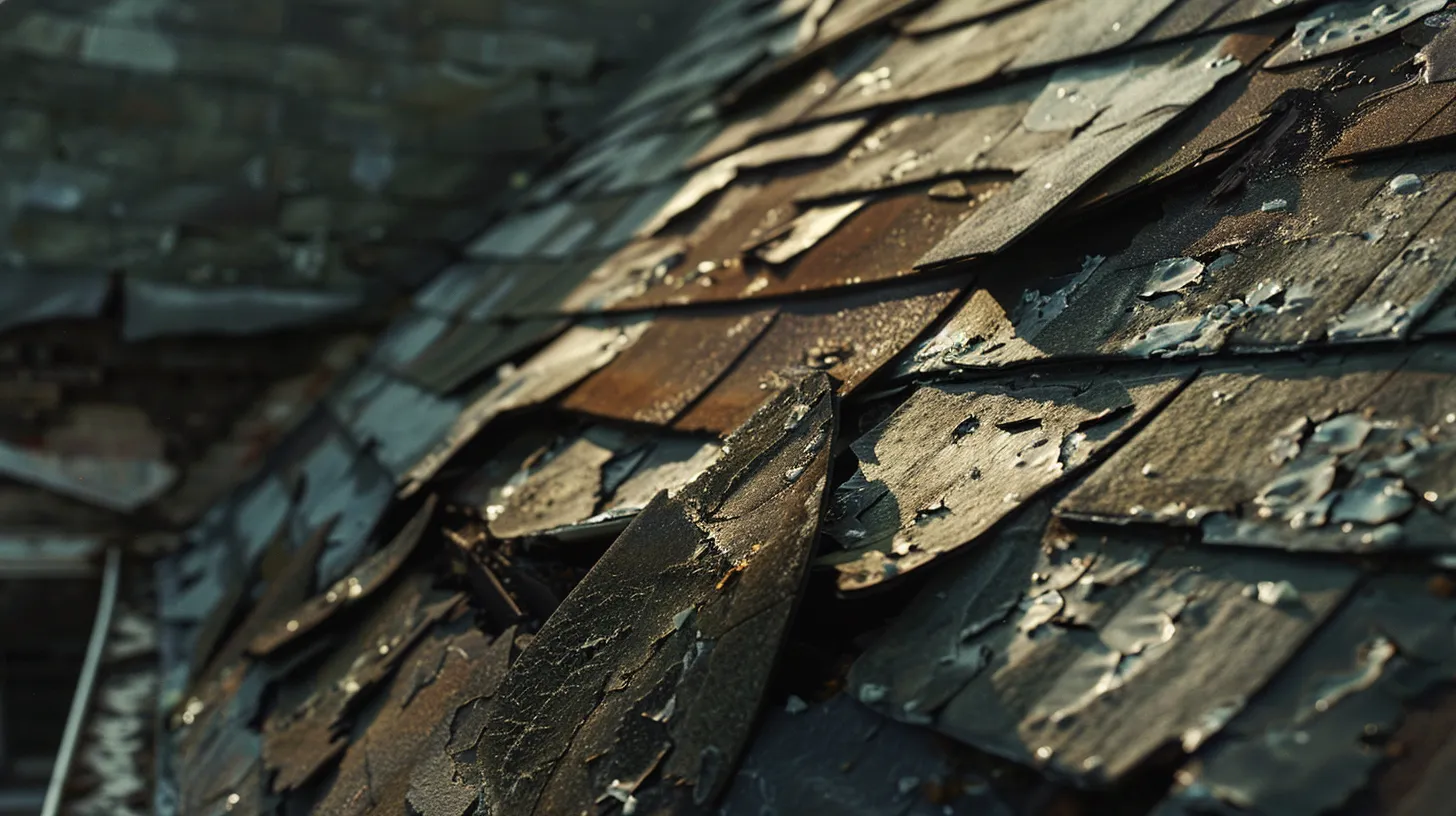
Spotting the Signals: Time for a Roof Replacement?
Is your roof showing signs of wear and tear? Recognizing when your roof needs replacement is crucial for protecting your home and avoiding costly water damage. This guide will help you identify key indicators such as visible shingle damage, leaks, and sagging areas. By learning to spot these signs early, you can prevent major issues and save money in the long run. We’ll also cover how to assess your roof’s age and the impact of moss growth, empowering you to make informed decisions about your home’s most important protective feature.
Key Takeaways
- Regular roof inspections help identify wear and tear before issues escalate
- Water stains on ceilings and walls indicate potential roof leaks requiring immediate attention
- Sagging or uneven roof areas often signal structural problems needing professional assessment
- Moss and fungi growth on roofs can lead to material deterioration and leaks
- Increased energy bills may indicate roof inefficiency, suggesting the need for replacement
Assessing the Age of Your Roof
Assessing your roof’s age is crucial in determining if it needs replacement. We’ll guide you through identifying common roofing materials’ lifespans, pinpointing your roof’s installation date, and recognizing aging signs. Learn how factors like moss growth, flashing condition, and attic mold can impact your home insurance and inform your decision to replace your roof based on its age.
Determining the Lifespan of Common Roofing Materials
Understanding the lifespan of common roofing materials is essential for assessing your roof’s age and determining if it needs replacement. Asphalt shingles typically last 20-30 years, while metal roofs can endure for 50-70 years. Concrete tiles offer longevity of 50+ years, and slate roofs can last over a century with proper maintenance.
Regular inspections help you gauge wear and tear, allowing you to address issues before they escalate. Factors like extreme weather, including wind and hail, can significantly reduce a roof’s lifespan. By recognizing the expected durability of your roof tiles and monitoring their condition, you can make informed decisions about repair or replacement, ensuring your home remains protected.
Identifying the Installation Date of Your Roof
To identify your roof’s installation date, check your home’s documentation, including warranties and maintenance records. For metal roofs, look for signs of weathering or rust around chimney flashing. If you notice algae or mildew growth, it may indicate an aging roof, especially in humid climates.
Consider contacting the previous homeowner or the roofing company that installed your roof for accurate information. You can also inspect the attic for signs of roof age, such as water stains or daylight penetration. Remember that different roofing materials have varying lifespans, so factor this into your assessment.
Recognizing Signs of Aging Roof Components
Inspect your roof for signs of wear, such as curling or missing shingles, which indicate aging. Check metal components like flashing and vents for rust or deterioration, as these can compromise your roof’s integrity. Pay attention to sagging areas, especially after heavy snow, as this may suggest structural issues.
Examine your attic for proper ventilation, as poor airflow can accelerate roof aging. Look for daylight penetrating through the roof boards or signs of water damage. If you notice granules from asphalt shingles in your gutters, it’s a clear sign your roof is nearing the end of its lifespan.
Considering Replacement Based on Roof Age
As your roof ages, it becomes more susceptible to moisture infiltration and roof leaks. If you notice cracked shingles or other signs of wear, it’s time to consult a roofing contractor about potential replacement. Remember, addressing these issues promptly can prevent more extensive damage to your home’s structure.
Consider the age of your roof in relation to its expected lifespan. If your roof is nearing or has surpassed its projected durability, it’s wise to start planning for replacement, even if you haven’t experienced significant issues. This proactive approach can save you from unexpected repairs and protect your home from water damage.
The age of your roof tells a story. Now, let’s look closer at the signs it’s trying to show you.
Identifying Visible Shingle Damage
Identifying visible shingle damage is crucial in determining if you need roof replacement. Learn to spot cracked, curling, or buckling shingles, understand the impact of missing shingles, examine granule loss in asphalt shingles, and safely inspect your roof’s surface. These key indicators help you assess potential leaks and roofing issues, guiding your decision on whether to replace your roof and estimate roof replacement costs.
Spotting Cracked, Curling, or Buckling Shingles
During roof inspections, look for cracked, curling, or buckling shingles as they’re clear signs your roof may need replacement. These issues often indicate aging or weather damage, potentially leading to a leaky roof if left unaddressed. Regular checks can help you spot these problems early, potentially avoiding a full roof replacement.
Cracked shingles leave your roof vulnerable to water infiltration, while curling and buckling can create gaps that compromise your roof’s integrity. If you notice widespread damage across your roof’s surface, it’s time to consult a professional about roof replacement options. Remember, addressing these issues promptly can prevent more extensive and costly repairs down the line.
Understanding the Impact of Missing Shingles
Missing shingles can significantly impact your roof’s integrity, leading to potential water damage and the need for roof replacement. When you notice bare spots on your roof, it’s crucial to address them promptly with roof repairs to prevent further issues. These exposed areas allow water to seep beneath the remaining shingles, potentially causing rot and leaks.
If you spot multiple missing shingles, especially after severe weather, consult a licensed roofing contractor to assess the damage. They can determine whether simple repairs will suffice or if a full replacement is necessary. Remember to check your gutters for shingle granules, as excessive granule loss often indicates it’s time for a new roof.
Examining Granule Loss in Asphalt Shingles
During your roof check, pay close attention to granule loss in asphalt shingles, as it’s a key indicator of roof damage. Excessive granules in your gutters or at the base of downspouts suggest your shingles are deteriorating, potentially leading to a leaky or sagging roof. This wear can compromise your roof’s protective layer, making replacement necessary.
To assess granule loss, examine your shingles closely for bare spots or a change in color. If you notice significant areas where granules have worn away, it’s time to consult a professional about roof replacement. Remember, addressing this issue promptly can prevent further damage to your home’s structure and ceiling.
Safely Inspecting Your Roof’s Surface
Safely inspect your roof’s surface after severe weather or storms to assess potential damage. Use binoculars or a drone to examine shingles, clay tiles, and other roofing materials from the ground, looking for signs of wear or displacement. Pay attention to areas around downspouts and valleys where water accumulates, as these are prone to accelerated deterioration.
If you must climb onto your roof, ensure proper safety measures are in place, including a secure ladder and non-slip footwear. Check for loose or missing shingles, damaged flashing, and signs of water pooling. Remember that different roofing materials have varying life expectancies, so consider your roof’s age when assessing its condition.
The shingles told their story. Inside, water whispered its secrets.
Detecting Leaks and Interior Water Damage
Detecting leaks and interior water damage is crucial in determining if you need a new roof. Learn to check for water stains on ceilings and walls, inspect your attic for moisture or mold, recognize signs of roof leaks, and address water damage promptly. These indicators can help you identify potential roofing issues before they escalate, ensuring timely roof replacement when necessary.
Checking for Water Stains on Ceilings and Walls
Regularly inspect your ceilings and walls for water stains, as these can indicate roof leaks requiring immediate attention. Look for discolored patches, peeling paint, or bubbling wallpaper, especially after heavy rain. These signs often appear before you notice active leaks, allowing you to address roofing issues early.
Pay close attention to corners, areas around windows, and spots near chimneys or vents, as these are common entry points for water. If you notice multiple water stains or a pattern of damage, it may signal widespread roofing problems. In such cases, consult a professional to assess whether your roof needs replacement to prevent further interior damage.
Inspecting the Attic for Moisture or Mold
Regularly inspect your attic for signs of moisture or mold, as these can indicate roof leaks requiring immediate attention. Look for dark spots on the wood, damp insulation, or a musty odor. These signs often appear before you notice water stains on your ceilings, allowing you to address roofing issues early.
Use a flashlight to examine the underside of the roof deck and rafters for water stains or mold growth. Pay special attention to areas around vents, chimneys, and where roof planes intersect, as these are common entry points for water. If you discover extensive moisture or mold issues, consult a professional to assess whether your roof needs replacement to prevent further damage to your home’s structure.
Recognizing the Signs of Roof Leaks
Be alert for subtle signs of roof leaks, such as small water spots on your ceilings or walls, especially after heavy rain. Check for damp areas in your attic and look for daylight penetrating through roof boards, which can indicate potential leak points. Pay attention to any musty odors, as these can signal hidden moisture issues.
Inspect your home’s exterior for missing or damaged shingles, as these can allow water to seep into your home. Look for water stains on exterior walls or siding, which may indicate that water is bypassing your roof’s protective layers. If you notice any of these signs, consult a professional roofer to assess whether you need repairs or a full roof replacement.
Addressing Water Damage Promptly to Prevent Further Issues
When you detect water damage, act quickly to prevent further issues and minimize repair costs. Start by identifying and addressing the source of the leak, which may require professional inspection of your roof. Remove any standing water and dry affected areas thoroughly to prevent mold growth and structural damage.
Document the damage for insurance purposes and consult a roofing expert to assess whether repairs or a full replacement is necessary. Prompt action can save you from extensive renovations and protect your home’s value. Remember, even minor leaks can lead to significant problems if left unaddressed, potentially compromising your roof’s integrity and your home’s safety.
The roof spoke its truth through leaks and stains. Now, its sagging lines revealed a new chapter.
Observing Sagging or Drooping Roof Areas
Observing sagging or drooping roof areas is crucial in determining if your roof needs replacement. Learn to identify uneven spots, understand structural causes, evaluate repair urgency, and know when to consult professionals. These skills help you assess your roof’s condition accurately, ensuring timely action to protect your home’s integrity and value.
Identifying Areas Where the Roof Appears Uneven
Inspect your roof’s surface for uneven areas, which can indicate structural issues requiring immediate attention. Look for dips, waves, or sagging spots along the roofline, as these often signal underlying problems like water damage or weakened support beams. Pay special attention to areas around chimneys, vents, and where different roof planes meet, as these are common trouble spots.
To identify uneven areas, stand back from your house and examine the roof’s profile from different angles. Use a level or straight edge to check for deviations in the roof’s plane if you can safely access it. Remember, even slight irregularities can worsen over time, potentially leading to more severe damage and the need for a full roof replacement.
Understanding Structural Causes of Roof Sagging
Roof sagging often stems from structural issues that compromise your roof’s integrity. Common causes include water damage weakening support beams, inadequate roof ventilation leading to moisture buildup, or excessive weight from snow or improperly installed roofing materials. Understanding these factors helps you address the root cause and determine if you need a roof replacement.
You should also consider the age of your home and any recent renovations that might have affected the roof structure. Sometimes, removing load-bearing walls or adding extra weight to the attic can lead to roof sagging. If you notice any signs of sagging, consult a professional roofer to assess the structural integrity and recommend appropriate solutions, which may include reinforcing trusses or a complete roof replacement.
Evaluating the Urgency of Repair or Replacement
Evaluate the urgency of repair or replacement by assessing the extent of sagging and its impact on your roof’s structural integrity. If you notice significant drooping or uneven areas, especially if they’re expanding rapidly, it’s crucial to act quickly. Immediate action can prevent further damage and potentially save you from a complete roof collapse.
Consider factors like the age of your roof, recent weather events, and any visible water damage when determining repair urgency. If the sagging is localized and your roof is relatively new, repairs might suffice. However, if your roof is nearing the end of its lifespan or shows widespread sagging, replacement is likely the most cost-effective long-term solution.
Consulting Professionals for Structural Assessment
When you observe sagging or drooping areas on your roof, it’s crucial to consult professional roofers for a thorough structural assessment. These experts can identify underlying issues that may not be visible to the untrained eye, such as water damage, weakened support beams, or inadequate ventilation. They’ll use specialized tools to measure the extent of the sagging and determine if your roof needs immediate replacement.
During the assessment, professionals will evaluate your roof’s overall condition, including the age of materials and any previous repairs. They can provide you with a detailed report on the structural integrity of your roof and recommend the most cost-effective solution, whether it’s targeted repairs or a full roof replacement. This expert advice helps you make an informed decision to protect your home and avoid potential safety hazards.
Sagging areas weren’t the only signs of trouble. Moss and mold had quietly taken hold, thriving in the damp corners.
Noticing Moss, Mold, or Fungi Growth
Noticing moss, mold, or fungi growth on your roof can signal potential issues requiring attention. Learn how vegetation affects roof health, safely remove unwanted growth, prevent future development, and assess when these growths indicate deeper problems. Understanding these aspects helps you maintain your roof’s integrity and determine if replacement is necessary.
Understanding How Vegetation Affects Roof Health
Vegetation growth on your roof can significantly impact its health and longevity. Moss, mold, and fungi retain moisture, leading to prolonged dampness that can deteriorate roofing materials. This moisture retention can cause shingles to lift, creating entry points for water and potentially leading to leaks.
As these organisms grow, their roots can penetrate and damage the roof’s surface, compromising its structural integrity. Over time, this damage can escalate, requiring extensive repairs or even a full roof replacement. Regular inspections and prompt removal of any vegetation growth can help prevent these issues and extend your roof’s lifespan.
Removing Unwanted Growth Safely and Effectively
To remove unwanted growth from your roof safely and effectively, start by applying a mixture of water and mild detergent to the affected areas. Use a soft-bristled brush to gently scrub the surface, working from the top down to avoid lifting shingles. Rinse thoroughly with clean water, ensuring all cleaning solution is removed to prevent further damage.
For stubborn growth, consider using a commercial roof cleaner specifically designed for moss and algae removal. Apply the product according to the manufacturer’s instructions, and always wear protective gear, including non-slip shoes and safety harnesses when working on your roof. After cleaning, install zinc or copper strips along the roof’s peak to prevent future growth, as these metals create an environment inhospitable to moss and fungi.
Preventing Future Moss or Algae Development
Prevent future moss or algae growth by improving your roof’s drainage and sunlight exposure. Trim overhanging branches to increase sunlight and reduce moisture retention. Install zinc or copper strips along your roof’s ridge, as these metals create an environment that inhibits moss and algae growth.
Regularly clean your gutters to ensure proper water flow and reduce moisture accumulation on your roof. Consider applying a roof coating designed to resist moss and algae growth, especially if you live in a humid climate. These preventive measures can significantly extend your roof’s lifespan and reduce the need for premature replacement.
Assessing When Growth Indicates Deeper Problems
When assessing moss, mold, or fungi growth on your roof, look for signs that indicate deeper problems. If you notice extensive growth covering large areas of your roof, it may suggest long-term moisture issues that have compromised the underlying structure. Pay attention to any soft or spongy spots when walking on your roof, as these can indicate water damage and rotting wood beneath the surface.
Check for growth patterns that align with your roof’s drainage paths or areas where water tends to pool. If you see consistent growth in these areas, it could signal inadequate drainage or damaged flashing that’s allowing water to penetrate your roof’s protective layers. In such cases, consult a professional roofer to determine if your roof needs replacement to address these underlying issues and prevent further damage to your home.
The moss and fungi were warning signs. But the real shock came when the energy bills arrived.
Experiencing Increased Energy Bills
Experiencing increased energy bills can signal roof issues requiring replacement. Learn how energy loss connects to roof inefficiency, inspect for poor insulation or ventilation, identify drafts related to roof problems, and consider energy-efficient roofing options. Understanding these factors helps you determine if your roof needs replacement to improve energy efficiency and reduce costs.
Connecting Energy Loss to Roof Inefficiency
Your roof’s inefficiency can directly impact your energy bills. As your roof ages or becomes damaged, it may allow more heat to escape during winter and enter during summer, causing your HVAC system to work harder. This increased energy consumption often results in higher utility costs, signaling potential roof issues.
To identify if your roof is contributing to energy loss, monitor your bills for unusual spikes, especially during extreme weather. Compare your current energy usage to previous years, accounting for any changes in household habits or appliances. If you notice a consistent increase without other explanations, your roof might be the culprit, indicating it’s time to consider replacement options.
Inspecting for Poor Insulation or Ventilation
Inspect your attic for signs of poor insulation or ventilation, which can contribute to increased energy bills. Look for gaps in insulation, damp or compressed insulation materials, and insufficient ventilation in the attic space. These issues can lead to heat loss in winter and heat gain in summer, forcing your HVAC system to work harder.
Check your roof vents for blockages or damage that might impede proper airflow. Ensure soffit vents are clear and functioning correctly. If you notice ice dams forming on your roof’s edges during winter, it often indicates inadequate attic insulation or ventilation. Addressing these issues can significantly improve your home’s energy efficiency and may require professional roof assessment or replacement.
Identifying Drafts Related to Roof Issues
To identify drafts related to roof issues, conduct a thorough inspection of your home’s interior. Pay attention to areas near windows, doors, and ceiling corners, especially on upper floors. Use your hand to feel for air movement or hold a lit candle to detect subtle drafts that may indicate gaps in your roof’s structure.
Check for daylight penetrating through your roof boards in the attic, as this can signify potential draft sources. If you notice cold spots or uneven temperatures in different rooms, particularly those directly under the roof, it may indicate air leakage through your roofing system. These drafts not only increase your energy bills but also suggest your roof might need replacement to improve your home’s overall energy efficiency.
Considering Energy-Efficient Roofing Options
When considering energy-efficient roofing options, look for materials with high solar reflectance and thermal emittance. Cool roofs, made from reflective materials or coatings, can significantly reduce heat absorption and lower your cooling costs. Metal roofing, particularly those with special reflective coatings, can be an excellent choice for energy efficiency and longevity.
Consider green roofing systems that incorporate vegetation, providing natural insulation and reducing urban heat island effects. These options not only improve energy efficiency but also offer environmental benefits. When selecting a new roof, evaluate its Energy Star rating and potential for energy savings to make an informed decision that aligns with your home’s needs and your budget.
Frequently Asked Questions
How can I determine if my roof is old enough to need replacement?
To determine if your roof needs replacement, look for signs like missing or curling shingles, excessive granules in gutters, visible sagging, or water stains on ceilings. Age is also crucial; most asphalt shingle roofs last 20-30 years. Consider a professional inspection for a thorough assessment.
What are the signs of visible damage to roof shingles?
Visible signs of roof shingle damage include curled or missing shingles, cracks, bald spots where granules have worn away, dark streaks from algae growth, and sagging areas. Look for loose or exposed nails, damaged flashing, and signs of water infiltration in your attic or ceiling.
How do I identify leaks or water damage from a failing roof?
Look for water stains on ceilings, walls, or in the attic. Check for missing or damaged shingles, sagging roof areas, and signs of mold growth. Be alert to musty odors, peeling paint, or warped wood, which can indicate hidden water damage from a failing roof.
What does a sagging or drooping roof indicate about its condition?
A sagging or drooping roof typically indicates structural issues. This may be due to water damage, inadequate support, or aging materials. It’s a serious problem that requires immediate professional attention to prevent further damage and ensure your home’s safety and integrity.
Can moss growth on my roof signal the need for replacement?
Moss growth on your roof can indicate moisture issues and potential damage, but it doesn’t always necessitate replacement. Regular roof inspections and professional cleaning can help address moss problems and extend your roof’s lifespan. However, if moss has caused significant deterioration, replacement might be necessary.
Conclusion
Recognizing key indicators for roof replacement is crucial for maintaining your home’s structural integrity and energy efficiency. By regularly assessing your roof’s age, visible damage, leaks, sagging areas, and unwanted growth, you can prevent costly repairs and potential safety hazards. Timely identification of these signs allows you to make informed decisions about repairs or replacement, ultimately protecting your home and investment. Stay vigilant and consult professionals when needed to ensure your roof continues to provide reliable protection for years to come.




